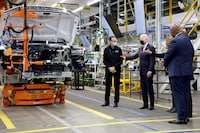Autoworkers at a General Motors electric-vehicle battery plant in Ohio cast the final votes Thursday in a union election that experts say will begin to the define the future of the auto sector and labor movement in the fight against climate change.
Ohio workers at electric-vehicle battery plant hold vote on unionizing

Car manufacturers are sprinting toward an EV future, powered in part by historic clean-energy investments pushed by the Biden administration and Democrats in Congress.
But many of their new plants are slated for states outside the industrial Midwest, the auto sector’s traditional geographic center. The “Big Three” automakers — GM, Ford and Stellantis, previously known as Chrysler — have sent much of the work on EVs and their component batteries to the South, where companies have eyed tax incentives dangled by governors and lower labor costs that are attributable in part to weaker unions.
Those facilities also need fewer workers, because EVs generally require far fewer parts than vehicles with internal-combustion engines. That translates to 40 percent fewer workers, according to Ford chief executive Jim Farley.
Labor officials have said that could spell an existential threat to autoworkers and their powerful union. A UAW study in 2018 found that mass adoption of EVs endangered 35,000 jobs. Jobs in EV manufacturing pay $15 to $16 per hour, far less than the $30 hourly rates of Detroit autoworkers.
“If the companies that are being given huge subsidies to fight climate change from the federal government are using that money to pull jobs out of the industrial heartland and moving them somewhere else, it will be impossible to sustain the middle class and fight climate change,” said Damon Silvers, a visiting professor at University College London and the former policy director of the AFL-CIO.
“This is the thing that I think is missing in the environmental discourse about climate change. Fighting climate change is a political and economic fight and you’ve got to have the support of working people in order to win that fight.”
GM chief executive Mary Barra has said her company supports the unionization drive.
“We have a very productive relationship with our labor force. We work together on safety, which is fundamental, and quality,” she told Bloomberg News last month. “Obviously, the employees are going to be voting, but we are supportive.”
An LG spokeswoman said the company would not comment on the election until after results have been announced, most likely Friday morning.
Ultium spokeswoman Brooke Waid said the company “respects workers’ freedom to choose union representation” and would comply with federal laws regulating the election. The company declined to recognize UAW representation voluntarily over the summer, triggering a formal vote.
The union needs a simple majority of voters for victory. The plant has roughly 900 workers.
“If that plant is not a UAW plant, it is a symbol with a spotlight on it of the deterioration of the UAW’s grasp on autoworkers,” said Erik Gordon, a clinical assistant professor at the University of Michigan’s Ross School of Business. “If it is a UAW plant, it is a symbol of the UAW extending its power and relevance into EV battery plants, the future.”
It would also, experts say, lay down a marker in northwest Ohio — particularly Warren and neighboring Lordstown — a historical heart of union country and a GM region.
“The culture in Lordstown, the workers there have been as pro union, anti-company activist as any assembly plant in the country,” Gordon said.
The local union jousted with GM management for decades there over pay and working conditions. A shift in American consumer preferences away from sedans — Lordstown’s bread and butter — to trucks and SUVs, led GM to shutter the Lordstown plant in 2019. GM later sold the facility to Lordstown Motors, an EV start-up. Ultium broke ground on the Warren battery plant in May 2020.
GM has said it will sell only zero-emission vehicles by 2035, posing a threat, along with other automakers, to Tesla’s dominance in the EV market. Though the luxury carmaker owned by tech mogul Elon Musk still claims 64 percent of the EV market share, according to Cox Automotive Group, steep investments from Hyundai and Ford have cut into its margin.
The Chevrolet Bolt electric vehicle, with a sticker price of $25,600, was the third most popular EV in the quarter that ended Sept. 30, Cox reported, behind the Tesla Model Y and Tesla Model 3 — which start at $65,000 and $45,000, respectively.






